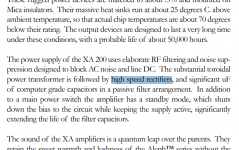Unknown TO220 Diodes (fast recovery Bridge Rectifier)f. Horch 3.0S and Threshold 4000
Usual 50/60 Hz bridge rectifier are versions like this series:
https://www.farnell.com/datasheets/2864019.pdf
Such versions are sometimes replaced by discrete bridge rectifier versions consist of 4 pcs. single diodes in TO220 outline for getting ultra fast switching character and/or ultra fast recovery behavior - go to URL's as follow for various examples:
https://unitedsic.com/datasheets/DS_UJ3D06530TS.pdf
https://www.st.com/resource/en/datasheet/stth12r06.pdf
STTH12R06 - 600 V, 12 A Turbo 2 Ultrafast Diode - STMicroelectronics
https://www.mouser.de/datasheet/2/427/VISH_S_A0003169751_1-2568737.pdf
The one from the attached images are mounted in a power amplifier from the German brand Horch, model "3.0S"
http://www.horch-gmbh.de/Produkte/HORCH 3.0 S.pdf
also suited for replace the usual rectifier (like to find under the first URL) in the cheaper Horch model "3.0"
http://www.horch-gmbh.de/Produkte/HORCH 3.0v.1.pdf
No additional snubber parts like to see under
https://web.archive.org/web/2010040...oltSecond/Rectify_1/rectifiers_and_xfmrs.html
were used
Maybe one diode is flawed - consequence was an extremely loud hum of one of both toroidal transformer (by measuring with diode tester no abnormalities are to observe - i. e. not shorted and no interruption).
The used capacitors are big cans with 33.000uF and 80VDC from FT cap.
Unfortunately the type designation of all diodes from TO220 surface was removed by grinding - thus the question rises up, what should I use for the right replacement.
I filed the topic here because the same problem also occurred with the Threshold 4000 vintage power amplifier (the usual 50/60Hz rectifier - go to
https://pdf1.alldatasheet.com/datasheet-pdf/view/1099761/NJSEMI/MDA3502.html
where was also replaced the mentioned rectifier by four pieces of fast diodes in the TO220 outline - also without additional snubber parts) - type designation from TO220 surface was here also removed by grinding from the repair guys who made this modification at least 20 years ago.
I. e. I have here the same problem to choice the right replacement.
Therefore the question: what diodes should I prefer therefore and for high power amplifiers in general ?
Thank you very much for your information
This threads don't provide the wanted hints.
Reduced diode switching by placing a cap across
Standard Silicon Diode Rectifier's VS Ultra Fast
Suggestions for Ultrafast Diode.
Fast recovery diodes
Suggestions pro/con three different fast diodes
https://linearaudio.net/article-detail/2242
Fast Recovery rectifier diodes
schottky vs. soft/fast recovery diodes
fast vs. slow rectifiers
Usual 50/60 Hz bridge rectifier are versions like this series:
https://www.farnell.com/datasheets/2864019.pdf
Such versions are sometimes replaced by discrete bridge rectifier versions consist of 4 pcs. single diodes in TO220 outline for getting ultra fast switching character and/or ultra fast recovery behavior - go to URL's as follow for various examples:
https://unitedsic.com/datasheets/DS_UJ3D06530TS.pdf
https://www.st.com/resource/en/datasheet/stth12r06.pdf
STTH12R06 - 600 V, 12 A Turbo 2 Ultrafast Diode - STMicroelectronics
https://www.mouser.de/datasheet/2/427/VISH_S_A0003169751_1-2568737.pdf
The one from the attached images are mounted in a power amplifier from the German brand Horch, model "3.0S"
http://www.horch-gmbh.de/Produkte/HORCH 3.0 S.pdf
also suited for replace the usual rectifier (like to find under the first URL) in the cheaper Horch model "3.0"
http://www.horch-gmbh.de/Produkte/HORCH 3.0v.1.pdf
No additional snubber parts like to see under
https://web.archive.org/web/2010040...oltSecond/Rectify_1/rectifiers_and_xfmrs.html
were used
Maybe one diode is flawed - consequence was an extremely loud hum of one of both toroidal transformer (by measuring with diode tester no abnormalities are to observe - i. e. not shorted and no interruption).
The used capacitors are big cans with 33.000uF and 80VDC from FT cap.
Unfortunately the type designation of all diodes from TO220 surface was removed by grinding - thus the question rises up, what should I use for the right replacement.
I filed the topic here because the same problem also occurred with the Threshold 4000 vintage power amplifier (the usual 50/60Hz rectifier - go to
https://pdf1.alldatasheet.com/datasheet-pdf/view/1099761/NJSEMI/MDA3502.html
where was also replaced the mentioned rectifier by four pieces of fast diodes in the TO220 outline - also without additional snubber parts) - type designation from TO220 surface was here also removed by grinding from the repair guys who made this modification at least 20 years ago.
I. e. I have here the same problem to choice the right replacement.
Therefore the question: what diodes should I prefer therefore and for high power amplifiers in general ?
Thank you very much for your information
This threads don't provide the wanted hints.
Reduced diode switching by placing a cap across
Standard Silicon Diode Rectifier's VS Ultra Fast
Suggestions for Ultrafast Diode.
Fast recovery diodes
Suggestions pro/con three different fast diodes
https://linearaudio.net/article-detail/2242
Fast Recovery rectifier diodes
schottky vs. soft/fast recovery diodes
fast vs. slow rectifiers
Attachments
-
 horch3.0S-1.jpg548.4 KB · Views: 313
horch3.0S-1.jpg548.4 KB · Views: 313 -
 horch3.0S-3.jpg146 KB · Views: 286
horch3.0S-3.jpg146 KB · Views: 286 -
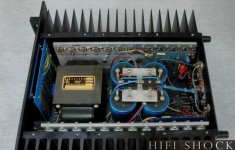 Threshold model-4000 open.jpg53.8 KB · Views: 331
Threshold model-4000 open.jpg53.8 KB · Views: 331 -
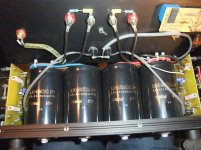 Horch 3.0S Capacitors.jpg1 MB · Views: 323
Horch 3.0S Capacitors.jpg1 MB · Views: 323 -
 Horch 3.0S bridge rectifier ultrafast-II.jpg870.3 KB · Views: 316
Horch 3.0S bridge rectifier ultrafast-II.jpg870.3 KB · Views: 316 -
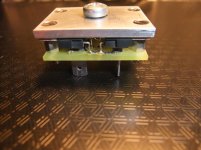 Horch 3.0S bridge rectifier ultrafast-I.jpg984.3 KB · Views: 273
Horch 3.0S bridge rectifier ultrafast-I.jpg984.3 KB · Views: 273 -
 Horch 3.0S bridge rectifier ultrafast-III.jpg980.1 KB · Views: 319
Horch 3.0S bridge rectifier ultrafast-III.jpg980.1 KB · Views: 319 -
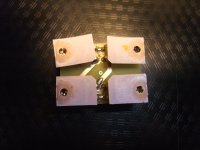 Horch 3.0S bridge rectifier ultrafast-IV.jpg979.2 KB · Views: 325
Horch 3.0S bridge rectifier ultrafast-IV.jpg979.2 KB · Views: 325 -
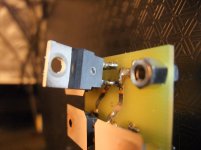 Horch 3.0S bridge rectifier ultrafast-V.jpg979.6 KB · Views: 294
Horch 3.0S bridge rectifier ultrafast-V.jpg979.6 KB · Views: 294
Last edited:
500A peak current is necessary (50 Hz version in "3.0" = KBPC50) - check out post 16+31 underMUR860 is a often a favorite… need to make sure you dont exceed the diode voltage thought…
SB
https://www.diyaudio.com/community/threads/high-speed-diode-to-220-package-for-aleph-x.27831/and this url's
https://www.diyaudio.com/community/threads/200v-50a-fast-recovery-power-rectifiers.28311/https://www.diyaudio.com/community/...ultrasofts-ultrafasts-and-fast-recovery.8683/https://www.diyaudio.com/community/threads/fast-vs-slow-rectifiers.8826/https://www.diyaudio.com/community/threads/fast-recovery-diodes.260404/https://www.diyaudio.com/community/threads/standard-silicon-diode-rectifiers-vs-ultra-fast.260165/https://www.diyaudio.com/community/threads/fast-recovery-rectifier-diodes.66542/https://www.diyaudio.com/community/threads/high-power-diodes-any-good.335154/https://www.diyaudio.com/community/threads/suggestions-pro-con-three-different-fast-diodes.339560/https://www.diyaudio.com/community/threads/fast-bridge-rectifier.74575/ (post #20)
Last edited:
Post #1 suggests that you have a copy of the article "Soft Recovery Diodes Lower Transformer Ringing by 10-20X" published in Linear Audio magazine.
I recommend that you type the last sentence of the Abstract of that paper, here in the Forum. Then type the last sentence of the Summary of that paper, here in the Forum. Finally, draw a conclusion from these two sentences, and type that too.
Other members may decide to post their own conclusions as well. Perhaps after a two month delay, in the same way that post #3 in this thread did not appear until two months after post #2.
I recommend that you type the last sentence of the Abstract of that paper, here in the Forum. Then type the last sentence of the Summary of that paper, here in the Forum. Finally, draw a conclusion from these two sentences, and type that too.
Other members may decide to post their own conclusions as well. Perhaps after a two month delay, in the same way that post #3 in this thread did not appear until two months after post #2.
Such diodes are common in computer SMPS on the low voltage side, though 600V rated.
Choose the current rating needed, and you are through.
If it is on the 50 Hz line there is no need for fast diodes.
Choose the current rating needed, and you are through.
If it is on the 50 Hz line there is no need for fast diodes.
No, I haven't this article (thank you very much for that advice), fortunately it is online here and very interesting:Post #1 suggests that you have a copy of the article "Soft Recovery Diodes Lower Transformer Ringing by 10-20X" published in Linear Audio magazine.
I recommend that you type the last sentence of the Abstract of that paper, here in the Forum. Then type the last sentence of the Summary of that paper, here in the Forum. Finally, draw a conclusion from these two sentences, and type that too.
Other members may decide to post their own conclusions as well. Perhaps after a two month delay, in the same way that post #3 in this thread did not appear until two months after post #2.
[Moderator edit
 : Link to copyright material removed]
: Link to copyright material removed]here on diyaudio are to find this threads in this case:
https://www.diyaudio.com/community/...ey-are-cool-and-quiet-too.351849/#post6138250https://www.diyaudio.com/community/threads/how-to-use-solid-state-rectification-the-best-way.374670/According this results of that investigation the approach of replacing 50/60 Hz diodes with ultra fast and fast recovery versions is completely wrong (as stated in post #5) - at least in relation to power supplies/transformers where a constant current is supplied.
But what is in cases of Class AB power amplifiers with 2x30 mA quiescent/idle current, where the current flow fluctuates to the beat of the music, i.e. dynamic conditions are present (5-10A peak current) ?
Last edited by a moderator:
this link should actually be a reference to the magazine issue, not the article itself
https://linearaudio.net/article-detail/2242to get the article one must pay € 2,99
https://linearaudio.net/article-detail/2242to get the article one must pay € 2,99
You might enjoy reading the owner's manual for the Pass Labs XA100 power amp. Their website makes it available for download, (here) . I mention this because the chief designer at Threshold became the chief designer at Pass Labs. Maybe the same thinking is applied to both Threshold amps and Pass Labs amps . . . . ??
A piece of page 14 is snipped out and presented below.
_
A piece of page 14 is snipped out and presented below.
_
Attachments
Good advice. Maybe an upgrade on X250 (in use by a friend) in this direction provide further sonic enhancement and is also a good choice for the Horch model from the headline.
Use UF instead of Schottky, the Schottky type do not work well at mains frequencies.
And much of the sharpness will be removed by the filter caps, which will do their job of damping the ripple.
And much of the sharpness will be removed by the filter caps, which will do their job of damping the ripple.
good advice again. In a XA100.5 clone are 4 pcs. MUR3020WT in use so as a RC network (maybe a CRC network) - go to the images underYou might enjoy reading the owner's manual for the Pass Labs XA100 power amp. Their website makes it available for download, (here) . I mention this because the chief designer at Threshold became the chief designer at Pass Labs. Maybe the same thinking is applied to both Threshold amps and Pass Labs amps . . . . ??
A piece of page 14 is snipped out and presented below.
_
https://www.behringer-electric.de/lautsprecher-service/pass-labs-diy/passlabs-xa100-5-mk2-diy/and post #64 under
https://www.diyaudio.com/community/threads/pass-x250-repair.327244/page-4to the below mentioned article there is this associated thread here on diyaudio
https://www.diyaudio.com/community/...rmer-snubber-using-quasimodo-test-jig.243100/
this link should actually be a reference to the magazine issue, not the article itself
https://linearaudio.net/article-detail/2242to get the article one must pay € 2,99
Last edited:
- Home
- Amplifiers
- Pass Labs
- Unknown TO220 Diodes (discrete Bridge Rectifier) for Horch 3.0S and Threshold 4000
